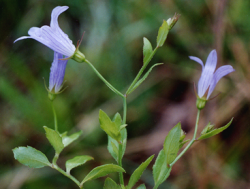
threatened

Illustration from Abrams and Ferris (1960)

Photo taken at Pt. Reyes, Marin County © 2001 Doreen L. Smith

Photo taken at Jughandle Reserve, Mendocino County © R. York/CNPS

Photo taken in the Scott Creek watershed by Dylan Neubauer--a similar habitat to that where the species has been found.

The yellow polygon indicates the occurrence has been extirpated

Historical range of Campanula californica.



This fact sheet was prepared by Dean W. Taylor under award NA04N0S4200074 from the National Oceanic and Atmospheric Administration (NOAA), U.S. Department of Commerce (DOC). The statements, findings, conclusions, and recommendations are those of the authors and do not necessarily reflect the views of the NOAA or the DOC.
© Copyright 2006, Elkhorn Slough Coastal Training Program
Last updated: Sep 3, 2007 11:02
Common Names - swamp harebell
Family - Campanulaceae (Bellflower Family)
State Status - none
Federal Status - none
Habitat
Borders of non-saline coastal marshes and lagoons, 1-405 m.
Key Characteristics
Perennial herb from slender rhizome; stems slender, clambering, and sparingly branched , 10–30 cm long, hairs stiff, recurved, on stem angles, leaf margins, ovary ribs; leaves alternate, ovate, crenate, petiole 0 or short, blade 10–20 mm long; flowers solitary and terminal, sepals spreading, corolla bell-shaped, lobes reflexed, pale blue, 8–15 mm long; style included (Morin 2013).
Flowering Period
June to October
Reference Population
Point Reyes National Seashore (Marin County).
Global Distribution
Mendocino, Marin, Santa Cruz (extirpated), and Sonoma counties of central and north coastal California (CNPS 2015).
Conservation
Last recorded in our region at the Camp Evers marsh site near Scotts Valley in 1944, an area that was subsequently developed thus causing the extirpation of this along with many other rare or disjunct species. Suitable habitat in the Watsonville Slough and the Scott Creek watershed requires additional field surveys.
In coastal Marin County, from Gualala to Manchester, there are small populations on wet shaded roadbanks and in fairly dense vegetation in seasonal standing freshwater. The plant is doing well at Pt. Reyes National Seashore in freshwater marshes and by springs and seeps in openings in the Bishop pine forest. The weak-stemmed plants are especially susceptible to trampling and consumption from heavy cattle grazing. This situation is exacerbated in dry years when grazing pressure increases in the marshy areas the plant favors. Light grazing seems neither to help nor hinder plant populations. In areas where livestock grazing has ceased, the plant has been outcompeted by other natives, and, less frequently, non-natives—especially in wetter years. Populations in Mendocino County have been negatively affected by logging operations.
References
Abrams, L. R. and R. Ferris. 1960. Illustrated Flora of the Pacific States, Vol. 4. Stanford University Press, Stanford, CA.
CNPS, Rare Plant Program. 2015. Campanula californica, in Inventory of Rare and Endangered Plants (online edition, v8-02). California Native Plant Society, Sacramento, CA. http://www.rareplants.cnps.org/detail/264.html [accessed 2 February 2015].
Morin, N. 2013. Campanula, in Jepson Flora Project (eds.). Jepson eFlora, http://ucjeps.berkeley.edu/cgi-bin/get_IJM.pl?tid=16957 [accessed 2 February 2015].
Nowicke, J. W. et al. 1992. Exine structure of pantoporate campanula (Campanulaceae) species. Annals of the Missouri Botanical Garden 79(1):65–80.
Shetler, S. G. and N. Morin. 1986. Seed morphology in North American Campanulaceae. Annals of the Missouri Botanical Garden 73(4):653–688.
Reviewers
Nancy Morin, Doreen Smith, and Bob Soost (August 2007).
